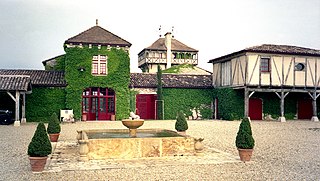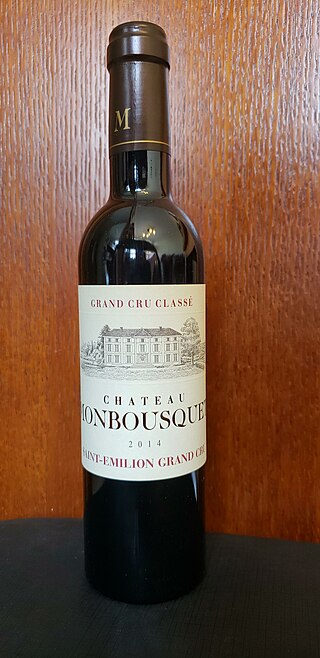
Graves is an important subregion of the Bordeaux wine region. Graves is situated on the left bank of the Garonne River, in the upstream part of the region, southeast of the city Bordeaux and stretches over 50 kilometres (31 mi). Graves is the only Bordeaux subregion which is famed for all three of Bordeaux' three main wine types—reds, dry whites and sweet wines—although red wines dominate the total production. Graves AOC is also the name of one Appellation d'origine contrôlée (AOC) which covers most, but not all of the Graves subregion.

Pessac-Léognan is a wine growing area and Appellation d'Origine Contrôlée, in the northern part of the Graves region of Bordeaux. Unlike most Bordeaux appellations, Pessac-Léognan is equally famous for both red and (dry) white wines, although red wine is still predominant. It includes the only red-wine producer outside the Haut-Médoc classified in the Bordeaux Wine Official Classification of 1855, the premier cru Château Haut-Brion, and also includes all of the châteaux listed in the 1953/59 classification of Graves. These classed growths account for a third of the wine produced in Pessac-Léognan.
Château Lascombes is a winery in the Margaux appellation of the Bordeaux region of France. The wine produced here was classified as one of fifteen Seconds Crus in the original Bordeaux Wine Official Classification of 1855. In the 1950s, the estate was purchased by French wine writer Alexis Lichine who continued to own part of the estate till 1971 when Bass Charrington took over principal ownership. In 2001 it was purchased by Yves Vatelot and US-based Colony Capital, who in 2011 sold it to the French insurance group MACSF. In addition to its premier cuvee, a second wine is also produced, under the name Chevalier de Lascombes. Additional brands are Château Segonnes, Rosé de Lascombes, Vin Sec Chevalier de Lascombes and Gombaud.

Château Haut-Bailly is a Bordeaux wine from the Pessac-Léognan appellation, ranked among the Crus Classés for red wine in the Classification of Graves wine of 1953 and 1959. The winery and vineyards are located south of the city of Bordeaux, in the commune of Léognan.
Château Desmirail is a winery in the Margaux appellation of the Bordeaux wine region of France. It was classified as one of fourteen Troisièmes Crus in the historic Bordeaux Wine Official Classification of 1855.

The wine regions of Bordeaux in France are a large number of wine growing areas, differing widely in size and sometimes overlapping, which lie within the overarching wine region of Bordeaux, centred on the city of Bordeaux and covering the whole area of the Gironde department of Aquitaine.

Château Lanessan is a Bordeaux wine estate in the Haut-Médoc appellation, located on the Left Bank of France’s Bordeaux wine regions in the commune of Cussac near Fort Médoc. The estate held a rating of Cru Bourgeois Supérieur, until this specific classification was annulled. Some critics have suggested that it ought to be elevated to a higher classification.

Château la Mission Haut-Brion is a Bordeaux wine from the Pessac-Léognan appellation, classed among the Crus Classés in the Graves classification of 1953. La Mission Haut-Brion is the sister property of the First Growth Château Haut-Brion. The winery, located in close vicinity of the city of Bordeaux, belongs to the wine region Graves, in the commune of Talence with additional property in Pessac.
Château Laville Haut-Brion was a Bordeaux dry white wine from the Pessac-Léognan appellation, which was ranked among the Crus Classés in the Classification of Graves wine of 1953. The estate is located in close vicinity of the city of Bordeaux, in the commune of Talence.
Château La Tour Haut-Brion was a Bordeaux wine estate from the Pessac-Léognan appellation within Graves, and was ranked as a Cru Classé for red wine in the Classification of Graves wine of 1953 and 1959. It was located in close vicinity of the city of Bordeaux, in the commune of Talence, adjoining Château La Mission Haut-Brion.

Château Latour-Martillac, previously Château La Tour-Martillac and known as Kressmann La Tour, is a Bordeaux wine from the Pessac-Léognan appellation, rated a Cru Classé in the 1953 Classification of Graves wine. The winery is located in the central part of France’s Bordeaux wine region Graves, in the commune of Martillac.
Château de Fieuzal is a Bordeaux wine from the Pessac-Léognan appellation, ranked among the Crus Classés for red wine in the Classification of Graves wine of 1953 and 1959, though the estate also produces a dry white wine which was not classified. The winery and vineyards are located south of the city of Bordeaux, in the commune of Léognan.
Domaine de Chevalier is a Bordeaux wine from the Pessac-Léognan appellation, ranked among the Crus Classés for red and white wine in the Classification of Graves wine of 1953 and 1959. The winery and vineyards are located south of the city of Bordeaux, in the commune of Léognan. It is one of a very few Bordeaux estates to be named domaine instead of château.

Château Malartic-Lagravière, originally Domaine de Lagravière, is a Bordeaux wine from the Pessac-Léognan appellation, ranked among the Crus Classés for red and white wine in the Classification of Graves wine of 1953 and 1959. The winery and vineyards are located south of the city of Bordeaux, in the commune of Léognan.

Château Smith Haut Lafitte is a Bordeaux wine from the Pessac-Léognan appellation, ranked among the Crus Classés for red wine in the Classification of Graves wine of 1953 and 1959. The winery and vineyards are located south of the city of Bordeaux, in the commune of Martillac.

Château Olivier is a Bordeaux wine from the Pessac-Léognan appellation, ranked among the Crus Classés de Graves for red and dry white wine in the Classification of Graves wine of 1953 and 1959. The winery and vineyards are located south of the city of Bordeaux, in the commune of Léognan.
Château Couhins is a Bordeaux wine estate from the Pessac-Léognan appellation, ranked among the GrandsCrus Classés for dry white wine in the Classification of Graves wine of 1959. The winery is located in close Southern vicinity of the city of Bordeaux, in the commune of Villenave-d'Ornon.

Château Couhins-Lurton is a Bordeaux wine from the Pessac-Léognan appellation, ranked among the Crus Classés for dry white wine in the Classification of Graves wine of 1959. The winery is located in close vicinity of the city of Bordeaux, in the commune of Villenave-d'Ornon.

Château Bouscaut is a Bordeaux wine from the Pessac-Léognan appellation, ranked among the Crus Classés for red and dry white wine in the Classification of Graves wine of 1953 and 1959. The winery and vineyards are located south of the city of Bordeaux, in the commune of Cadaujac.

Château Monbousquet is a Bordeaux wine which has the appellation Saint-Émilion, ranked Grand cru classé in the Classification of Saint-Émilion wine. The winery is located in the Right Bank of France’s Bordeaux wine region in the commune of Saint-Sulpice-de-Faleyrens, in the department Gironde.















